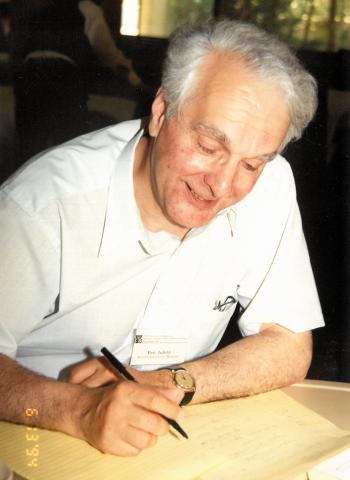With great regret we inform about the death of Professor Eryk Infeld.
He died on March 14, 2019.
In memory of Professor Infeld
Professor Eryk Infeld Was an outstanding physicist. He combined talent with great diligence and enthusiasm. After a short period of interest in the field of his father, Leopold, he engaged in plasma theory. He first graduated physics in Cambridge (BA in 1962), and then at the University of Warsaw (1963). He obtained his PhD (1966) and title of Associate Professor (1972) at Institute for Nuclear Research (IBJ) and full title of Professor at the Institute for Nuclear Problems (created from the part of divided IBJ) where, from 1985, he Was working as the Head of the Plasma Physics Laboratory. Professor Infeld Was a lecturer at many foreign universities, including Montreal and London. His works encompassed a broad spectrum of problems of physics, but especially processes described with nonlinear equations: from waves on water and plasma, through nonlinear optics and Bose-Einstein condensates, to road traffic intensity. He had a particular ability to create and perform detailed analyses of complex mathematical models for practical physical problems. Together with Professor George Rowlands from Warwick University, he wrote „Nonlinear Waves, Solitons and Chaos”, the first book which combined mathematics of models and practical issues so closely. The book has been widely popular since its publishing.
Eryk Infeld Was born on 8th January 1940 in Toronto, Canada. His father – Leopold Infeld, collaborator of Einstein, Born and Hoffman, Was one of the most outstanding Polish physicists and, after his return to Poland in 1950, he created the Polish school of theoretical physics from scratch and Was the first Director of Institute for Theoretical Physics. The mother of Eryk Infeld had a PhD title in mathematics, received at Cornell University, so many conversations in his family house were focused on scientific topics. In his childhood Eryk Infeld met every great mind of the world of physics during that time, including Einstein and Dirac. 9-year-old Eryk Infeld Was introduced to Einstein in 1949 in the latter’s family house in Princeton. When Eryk’s father finished a scientific dispute with Einstein, the creator of the theory of relativity went downstairs and had a „normal conversation” with the child of his friend. This event stuck on the mind of the future physicist forever.
Professor Eryk Infeld Was also a humanist, he Was a connoisseur of literature and art. He carried those interests from his family house as well. Profesor Infeld senior had a talent for writing, which is evident in his diaries, novel of „whom the gods love”, Evariste Galois and factual-analytical study „Quest”. In 1950, when the Infeld family Was returning to Poland from Canada, the future aunt of Professor Eryk, Margaret Schlauch, came along. She Was a professor of English and Scandinavian philology and at the time she already had scientific achievements and significant contributions in social or even political field. Having grown up in such environment, many years later Eryk himself wrote an amusing sensation novel „Cena Nobla” [Nobel’s price], which touched on a question, that has been bothering him for a long time: is it possible for a researcher from a peripheral institute, who has no connections to the scientific community and does not know people from the scientific frontline, to be awarded with the Nobel Prize. Professor Eryk Infeld gave numerous radio interviews and is an author of press releases about Einstein and the whole scientific community.
Eryk Infeld has been awarded the Golden Cross of Merit (1989) and Order of Polonia Restitua, the Knight’s Cross (2005). He Was a righteous man. He Was a man of thought, inspiring for his surroundings and highly respected in the scientific community. That’s who he Was and that’s how we shall remember him. Always smiling, with great sense of humour. He Was kind and patient towards everyone.
Our deepest sympathies to Professor’s loved ones.
/the memory has been prepared by Dr Piotr Goldstein and Professor Marek Trippenbach (Faculty of Physics, University of Warsaw)/





